.
"At Waterloo one battery of Old Guard fired its last shots
into the mass of Prussians and British, then stoically
stood by their cannons as if ready to fire again.
It was a bluff, but they halted the enemy cold
and gained their comrades time."
|

Artillery of the Imperial Guard.
[Artillerie de la Garde Impériale]
"... its gunnery generally excellent,
thanks to the annual competitions at La Fere."
- Colonel j. Elting, US Army
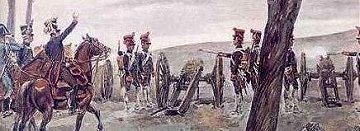 With the establishment of the Consulate, the Guard of the Directory,
had to form the Guard of the Consuls. In Novemner 1799 was issued a decree:
With the establishment of the Consulate, the Guard of the Directory,
had to form the Guard of the Consuls. In Novemner 1799 was issued a decree:
"Art. XIV -
The Consular Guard will be recruited only from men who will have distinguished themselves on the field of battle.”
PAY (per year):
troop earnings will be paid every 10 days, officers at the end of each month.
- Foot Grenadier and Chasseur 410, Drummer 500
- Horse Grenadier and Chasseur 450, Trumpeter 650
- Gunner 1st Class 500, 2nd Class 460
Money allocated for equipment, armament, horse-harness, and clothing:
- Foot Grenadier and Chasseur 258, Officer 800
- Horse Grenadier 517, Officer 1000
- Horse Chasseur 689, Officer 1500
- Gunner 689, Officer 1500
By a new decree of March 8, 1802, Bonaparte supplemented the new organization of the
Guard:
“Art. I - In the future the Guard will be made up ... of foot grenadiers and foot chasseurs, each made up of a staff, with 2 battalions; and each battalion, of 8 companies. A regiment of horse grenadiers composed of a staff with 4 squadrons of 2 companies each. A regiment of horse chasseurs, made up temporarily of 2 squadrons, 2 companies each one, with its staff. A horse artillery squadron, with a staff and company of foot artillery.”
"From the start the Guard Artillery had been intended to intervene en masse after
the battle had developed, and hence it was not used in the type of desultory outpost work
on which the line [artillery] was often dispersed.
... This was to be the pattern for the later battles of the Empire, with the Guard
[Artillery] providing the nucleus for ever bigger masses of guns. Especially after the
great concentration of 100 guns at
Wagram Napoleon became convinced that a really decisive
result could be obtained only with 36 guns or more. Against this weight of fire, he said
'Nothing will resist, whereas the same number of cannons spread out along the line would
not give the same results.' ... The artillery was no longer merely an auxiliary which
assisted each division to achieve a limited result. Instead, the Guard Artillery
mass could claim to be one of the great deciders of battles."
(Griffith - "French Artillery" p 36)
In 1813 Napoleon wrote to Clarke, Minister of War: "In most battles the Guard artillery
is the deciding factor since having it always at hand, I can take it wherever it is needed."
It was customary for the gunners to boldly handle their weapons.
In Wagram the Emperor ordered Lauriston to bring the Guard Artillery
and deploy south of Aderklaa. To the right of the 72 guns of the Guard Artillery were 40 guns
from the Army of Italy. The massive battery was deployed "well within musket range of the
white-coated infantry" ( James Arnold - "Napoleon Conquers Austria")
Napoleon pointed the Austrian lines and said "... erase the masses".
Each gun of Guard Artillery fired approx. 200 rounds. This tremendous fire made a breach in Austrian line between
Breitenlee and Sussenbrunn. The whitecoats were driven back, many hid in the village.
GdK Bellegarde deployed three batteries to fill the void, and they too were forced into
retreat. Only the
Austrian grenadiers held their ground.
In Lutzen 60 guns of the Guard Artillery appeared from behind a masking
ridge; stopped the victorious Prussians and Russians in their tracks; and prepared the way
for an infantry attack.
In Bautzen the central French attack was supported by 76 guns. But the terrain was
both too hilly and too soft for the fire to be effective, and the Russians were able to
preserve their artillery in fieldworks.
In Dresden one battery of the Old Guard Horse Artillery deployed near the redoubt and
almost annihilated the leading Russian jager regiment. The Guard Artillery was committed
on the second day in the main attack on the enemey line. The cannons came on in grand style
by successive batteries, and cleared the enemy from a wide zone to their front. Then,
however, they were inexplicably ordered to retire, and in his memoirs General Griois records
his fury at the waste of a good chance to break out.
In Leipzig 80 guns
of the Guard Artillery and 20 pieces of the line blew a convincing hole in the Russo-Prussian
line. "We advanced when our troops did and changed front as necessary to engage the best
targets." - General Griois, Foot Artillery of the Guard
In Hanau 50 guns of the Guard Artillery and the Guard Cavalry made a short work
of the Bavarians.
In Craonne and Montereau the Guard Artillery was able to make a decisive intervention
at the crises of the battles, in both cases on extremely narrow frontages.
In Arcis-sur-Aube the Guard Artillery came too late and deployed too slowly as
the guns had to use double teams to move through thick mud.
During the battle of Paris
the Guard artillery in La Villette were firing continuously. They sent for more ammunition.
Some ammunition caissons eventually reached them. The Guard again fired full speed until the
Prussian Guard appeared in the rear. Then they hurled 2 guns into the canal and abandoned
the other 2 as they retired before the advancing Prussians.
The Guard artillery suffered heavy losses. Major Bitsch was severely wounded, and Captain
Raoul and four majors were put out of action.
In Waterloo the ground was again too soft for ricochets and maneuvers. Wellington kept
his German-British-Dutch infantry in covered positions until French cavalry charged and
forced them to stand up. The French gunners got closer and inflicted very heavy casualties.
It was one of the most extraordinary and pitiful incidents in military history.
The British and German infantry stood out in the open whilst exposed to the merciless
artillery fire. Prussian officer Muffling (attached to Wellington) wrote: "The Duke was most
desirous of our arrival and had repeatedly declared that this was the last moment, and if we
did not arrive soon, he would be compelled to retreat." The junction of two big armies had
been accomplished.
Old Guard Artillery at Leipzig, 1813.
The French artillery made a gap in enemy's line;
three Russian infantry divisions, two Prussian brigades
and Russian cavalry corps were forced into a hasty withdrawal.
The situation was ripe for a massive attack,
breaking the enemy's line and winning the battle.
 The overall command over the French Grand Battery deployed on the Gallows Height
(few km south of Leipzig) had Antoine Count Drouot.
The Russians and Prussians had 52 guns against 96-137 French pieces (Old Guard artillery, few
pieces of Young Guard artillery, and part of Lauriston's and Victor's artillery).
Drouot's guns quickly dismounted 24 Allies pieces while the remaining enemy guns
hastily fell back and onto the road to Gulden-Gossa. Those Russian and Prussian gunners who
had no riding place on the cannons or limbers were running down the verges in hasty retreat.
Once the artillery was gone Eugene's Russian II Infantry Corps (3rd & 4th Division) became
the only target for Drouot's gunners.
The overall command over the French Grand Battery deployed on the Gallows Height
(few km south of Leipzig) had Antoine Count Drouot.
The Russians and Prussians had 52 guns against 96-137 French pieces (Old Guard artillery, few
pieces of Young Guard artillery, and part of Lauriston's and Victor's artillery).
Drouot's guns quickly dismounted 24 Allies pieces while the remaining enemy guns
hastily fell back and onto the road to Gulden-Gossa. Those Russian and Prussian gunners who
had no riding place on the cannons or limbers were running down the verges in hasty retreat.
Once the artillery was gone Eugene's Russian II Infantry Corps (3rd & 4th Division) became
the only target for Drouot's gunners.
Digby-Smith writes: "The situation of the Russians on Klux's right, in the open fields ...
was much worse. Lacking any cover at all, they suffered very heavy losses from artillery fire.
Shahovskoi ... reported to Prinz Eugen that his men were being destroyed. The prince rode
slowly along the line. At each battalion, his question 'How many men have you lost ?'
would be answered with a silent gesture to the lines of dead lying where they had fallen. ...
[Prinz Eugen] did nothing to alleviate the situation ... " (Digby-Smith, - p 86)
Then a French cannonball went through the prince's horse and thrown the rider to the ground.
The 3rd Division have suffered horrible casualties and was finally withdrawn towards
Gulden-Gossa. The 4th Division also got under fire and fell back on Crobern.
The withdrawal was covered by 6 Russian battalions. Drouot's battery also forced Mesenzov's
Russian 5th Division to fall back.
The fire was terrific. The fields were covered with smoke. Drouot
made a gap in enemy's line; three Russian infantry divisions, two Prussian brigades and
Russian cavalry corps were forced into a hasty withdrawal. The situation was ripe for a
massive attack, breaking the enemy's line and winning the battle. The cannons kept firing
until Murat's 10,000 cavalrymen began to advance. Then they fell silent as the advancing
masses obscured the line of fire.
Once the cavalry passed Napoleon ordered Drouot "The Monk" to take part of his Grand Battery
and push it forward. Marbot writes: "General Drout with 60 cannons aided the attack."
The crews manhandled the pieces back to hook them on to their limbers.
The ammunition wagons set off with their wheels digging great gouges into the
meadow. The guns rolled forward, with their chains and buckets swinging. The horrified
enemy was rapidly falling back.
Young Guard Artillery at Leipzig, 1813.
The flanking fire from Pacthod's artillery and infantry,
standing behind the Pleisse in the Rosenthal Woods,
was devastating and broke the Russian attack.
On the third day of the battle, the artillery of the Young Guard participted in the
heavy fighting north of Leipzig. At 4:30 PM Dabrowski's 4 battalions of Polish
infantry stood just north of the Halle suburbs. Pacthod's 1st Young Guard Division stood
in the Halle suburbs and behind the river. Fabian Sacken's Russian XI Corps moved south of Gohlis.
The Prussian I Corps under von Yorck was as a reserve in the second line on the height near
Gohlis.
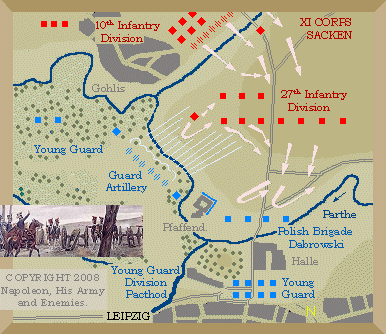 One of Sacken's three infantry divisions (27th under Neverovski) attacked Dabrowski.
Outnumbered 2 to 1 the Poles withdrew behind the Parthe River taking up positions to defend
the bridge. They were supported by a single company of Baden infantry. The loss of the Halle
suburb meant disaster to Napoleon and his army. Nafziger writes: "Gourgaud, one of Napoleon's
ADCs, recognized the danger, and reassured by Dabrowski that he would die before abandoning
his position, hurried to advise Napoleon of the threat. Pacthod's 1st Young Guard Division
(12 battalions and 3 batteries) was sent from Thonberg at the double, to support Dabrowski.
Pacthod moved his division forward and deployed his artillery in the Rosenthal Woods, on the
west bank of the Pleisse."
One of Sacken's three infantry divisions (27th under Neverovski) attacked Dabrowski.
Outnumbered 2 to 1 the Poles withdrew behind the Parthe River taking up positions to defend
the bridge. They were supported by a single company of Baden infantry. The loss of the Halle
suburb meant disaster to Napoleon and his army. Nafziger writes: "Gourgaud, one of Napoleon's
ADCs, recognized the danger, and reassured by Dabrowski that he would die before abandoning
his position, hurried to advise Napoleon of the threat. Pacthod's 1st Young Guard Division
(12 battalions and 3 batteries) was sent from Thonberg at the double, to support Dabrowski.
Pacthod moved his division forward and deployed his artillery in the Rosenthal Woods, on the
west bank of the Pleisse."
"... Sacken's attack with Neverovski's 27th Division was now supported by Lieven's 10th
Division, which was posted to Neverovski's left rear. Neverovski sent forward 5 battalions,
supported by 13th Position and 35th Light Battery ... However, the flanking fire from
Pacthod's artillery and infantry, standing behind the Pleisse in the Rosenthal Woods, was
devastating and broke the attack. Rachmanov's 4 battalions ... already terribly under
strength, were severely punished and forced to withdraw back to Gohlis. ... By 3 PM Sacken's
forces were once again pushing forward towards Pfafendorf, where the French Young Guard
batteries in the Rosenthal Woods once again showered them with shot and shell. The battle
degenerated into a skirmish fight with one jager battalion pushing across the Pleisse, in an
attempt to strike the artillery of the Young Guard there. ...
The Russian soldiers had fought with tenacity and many Russian officers and men fell in this battle. Neverovski,
Huene, Rachmanov, all fell as did many staff officers. All their sacrifices were in vain."
The Young Guard held the Pleisse River, while the Poles still controlled the Halle suburbs
and the gate.
Guard Artillery in the Battle of Hanau, 1813.
The Guard Artillery deployed in such a position
as to take enemy's artillery in flank.
At Hanau the French army (60,000-90,000 men under Napoleon) in retreat from Leipzig fought
its way through a road block of 30,000-45,000 Bavarians, Austrians and Cossacks under General
Wrede. On the 30th, Napoleon appeared in front of Hanau with a force of 15,000-20,000 men, with
another 15,000 following close behind.
French officer Marbot writes: "In the direction from which we were coming, a large forest,
through which the road runs, covers the approach to Hanau. The tall trees of this forest
allow movement without much difficulty. The town of Hanau is built on the other side of the
river Kinzig. ... It is true that the position he (Bavarian General Wrede) occupied barred the way to Frankfort and to France, and
he felt certain that he could prevent us from forcing a passage." (- Baron de Marbot)
The French infantry was unable to make progress in some woods, but when Drouot arrived with
the Guard artillery his preliminary reconnaissance showed him a profitable line of
attack. French Guard Cavalry led by Nansouty moved forward against the enemy cavalry on the left
flank. Nansouty's first line wheeled left to attack the infantry in the center.
Friant and Cambronne cleared the woods with 2 battalions of the Old Guard in skirmish order,
then Drouot defiled through them with 15 guns and deployed in such a position as to take
enemy's artillery in flank.
 "Behind this screen the reminder of the Guard Artillery deployed, making a total of 50 pieces.
When these guns had begun to throw the enemy into confusion the Guard Cavalry completed the
rout. The Bavarian cavalry then counterattacked, but Drouot held his own cavalry in front of
the guns until the very last minute. When the enemy had arrived at close range the French
cavalry then wheeled away to reveal the massed battery, which proceeded to make very short
work of the Bavarians." (Griffith - "French Artillery" p 46)
"Behind this screen the reminder of the Guard Artillery deployed, making a total of 50 pieces.
When these guns had begun to throw the enemy into confusion the Guard Cavalry completed the
rout. The Bavarian cavalry then counterattacked, but Drouot held his own cavalry in front of
the guns until the very last minute. When the enemy had arrived at close range the French
cavalry then wheeled away to reveal the massed battery, which proceeded to make very short
work of the Bavarians." (Griffith - "French Artillery" p 46)
Once clear of the wood they blew apart the static Bavarian troops
holding that part of the battlefield. They also dimounted 28 of the enemy's guns.
"As Wrede was sending infantry and cavalry reinforcements to the threatened sector, Sebastiani charged and broke the enemy horse, but
was in turn driven back to Drouot's grand battery by recently arrived Bavarian cavalry.
However the Bavarian success was short-lived.
Nansouty's Guard Cavalry spearheaded by the Old Guard Horse Grenadiers ferociously counterattacked. The "Gods", the Polish lancers,
and the Honor Guard cut their way through the outmatched Bavarian lighthorsemen.
Meanwhile, the Guard Dragoons charged and broke three battalion squares of enemy infantry
as the Old Guard Chasseurs broke and captured two entire Bavarian battalions.
The impetus of the Guard's Cavalry's charge disintegrated Wrede's entire command of the
left bank of the Kinzig." (Bowden - "Napoleon's Grande Armee of 1813" p 197)
Napoleon's victory had cost him 6,000, while Wrede suffered 9,000.
Napoleonic troops could now continue their move towards France.
|


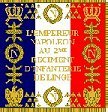

 With the establishment of the Consulate, the Guard of the Directory,
had to form the Guard of the Consuls. In Novemner 1799 was issued a decree:
With the establishment of the Consulate, the Guard of the Directory,
had to form the Guard of the Consuls. In Novemner 1799 was issued a decree: The overall command over the French Grand Battery deployed on the Gallows Height
(few km south of Leipzig) had Antoine Count Drouot.
The Russians and Prussians had 52 guns against 96-137 French pieces (Old Guard artillery, few
pieces of Young Guard artillery, and part of Lauriston's and Victor's artillery).
Drouot's guns quickly dismounted 24 Allies pieces while the remaining enemy guns
hastily fell back and onto the road to Gulden-Gossa. Those Russian and Prussian gunners who
had no riding place on the cannons or limbers were running down the verges in hasty retreat.
Once the artillery was gone Eugene's Russian II Infantry Corps (3rd & 4th Division) became
the only target for Drouot's gunners.
The overall command over the French Grand Battery deployed on the Gallows Height
(few km south of Leipzig) had Antoine Count Drouot.
The Russians and Prussians had 52 guns against 96-137 French pieces (Old Guard artillery, few
pieces of Young Guard artillery, and part of Lauriston's and Victor's artillery).
Drouot's guns quickly dismounted 24 Allies pieces while the remaining enemy guns
hastily fell back and onto the road to Gulden-Gossa. Those Russian and Prussian gunners who
had no riding place on the cannons or limbers were running down the verges in hasty retreat.
Once the artillery was gone Eugene's Russian II Infantry Corps (3rd & 4th Division) became
the only target for Drouot's gunners.
 One of Sacken's three infantry divisions (27th under Neverovski) attacked Dabrowski.
Outnumbered 2 to 1 the Poles withdrew behind the Parthe River taking up positions to defend
the bridge. They were supported by a single company of Baden infantry. The loss of the Halle
suburb meant disaster to Napoleon and his army. Nafziger writes: "Gourgaud, one of Napoleon's
ADCs, recognized the danger, and reassured by Dabrowski that he would die before abandoning
his position, hurried to advise Napoleon of the threat. Pacthod's 1st Young Guard Division
(12 battalions and 3 batteries) was sent from Thonberg at the double, to support Dabrowski.
Pacthod moved his division forward and deployed his artillery in the Rosenthal Woods, on the
west bank of the Pleisse."
One of Sacken's three infantry divisions (27th under Neverovski) attacked Dabrowski.
Outnumbered 2 to 1 the Poles withdrew behind the Parthe River taking up positions to defend
the bridge. They were supported by a single company of Baden infantry. The loss of the Halle
suburb meant disaster to Napoleon and his army. Nafziger writes: "Gourgaud, one of Napoleon's
ADCs, recognized the danger, and reassured by Dabrowski that he would die before abandoning
his position, hurried to advise Napoleon of the threat. Pacthod's 1st Young Guard Division
(12 battalions and 3 batteries) was sent from Thonberg at the double, to support Dabrowski.
Pacthod moved his division forward and deployed his artillery in the Rosenthal Woods, on the
west bank of the Pleisse."
 "Behind this screen the reminder of the Guard Artillery deployed, making a total of 50 pieces.
When these guns had begun to throw the enemy into confusion the Guard Cavalry completed the
rout. The Bavarian cavalry then counterattacked, but Drouot held his own cavalry in front of
the guns until the very last minute. When the enemy had arrived at close range the French
cavalry then wheeled away to reveal the massed battery, which proceeded to make very short
work of the Bavarians." (Griffith - "French Artillery" p 46)
"Behind this screen the reminder of the Guard Artillery deployed, making a total of 50 pieces.
When these guns had begun to throw the enemy into confusion the Guard Cavalry completed the
rout. The Bavarian cavalry then counterattacked, but Drouot held his own cavalry in front of
the guns until the very last minute. When the enemy had arrived at close range the French
cavalry then wheeled away to reveal the massed battery, which proceeded to make very short
work of the Bavarians." (Griffith - "French Artillery" p 46)
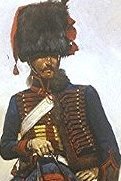 Picture: horse gunner of Imperial Guard.
Picture by Keith Rocco, USA.
Picture: horse gunner of Imperial Guard.
Picture by Keith Rocco, USA.
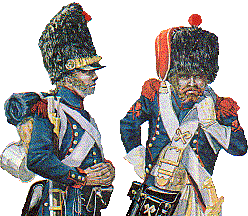 Right: gunner of Foot Artillery of the Guard in 1810-11,
Right: gunner of Foot Artillery of the Guard in 1810-11, In January 1800 was issued a decree organizing the Guard of the Consuls.
It consisted one company of light, or horse, artillery. Many of their officers served
with Bonaparte in Egypt. In the end of 1800 there were 12 guns of the Guard. Within few years
Napoleon enlarged the Guard artillery to several foot and horse batteries.
In January 1800 was issued a decree organizing the Guard of the Consuls.
It consisted one company of light, or horse, artillery. Many of their officers served
with Bonaparte in Egypt. In the end of 1800 there were 12 guns of the Guard. Within few years
Napoleon enlarged the Guard artillery to several foot and horse batteries.
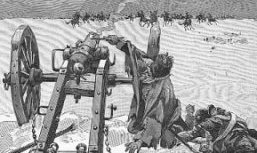 In 1812 the Guard artillery was in excellent shape.
Captain Antoine Augustin Pion des Loches of the Guard Foot Artillery wrote:
"Our teams were of the best, and the equipment left nothing to be desired,
but everyone was agreed that the horses were too tall and too strongly built,
and unsuited to supporting hardship and lack of abundant nourishment."
In 1812 the Guard artillery was in excellent shape.
Captain Antoine Augustin Pion des Loches of the Guard Foot Artillery wrote:
"Our teams were of the best, and the equipment left nothing to be desired,
but everyone was agreed that the horses were too tall and too strongly built,
and unsuited to supporting hardship and lack of abundant nourishment."

 Left: Subaltner of Foot Artillery of Imperial Guard, by Andre Jouineau.
Left: Subaltner of Foot Artillery of Imperial Guard, by Andre Jouineau.
 <- Picture: gunners of the Young Guard, by
A.Jouineau.
<- Picture: gunners of the Young Guard, by
A.Jouineau.
 Picture: ->
Picture: -> 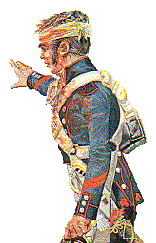
 Left: Corporal of the Artillery Train of the Guard in 1813-1814. Picture by Emir Bukhari from Griffith's - "French Artillery".
Left: Corporal of the Artillery Train of the Guard in 1813-1814. Picture by Emir Bukhari from Griffith's - "French Artillery". During campaign one company (battery) of artillery was teamed with one company of artillery train. The gunners handled the guns (cannons and howitzers) and the men of train handled the
draft horses, limbers, supply and ammunition wagons.
During campaign one company (battery) of artillery was teamed with one company of artillery train. The gunners handled the guns (cannons and howitzers) and the men of train handled the
draft horses, limbers, supply and ammunition wagons.
